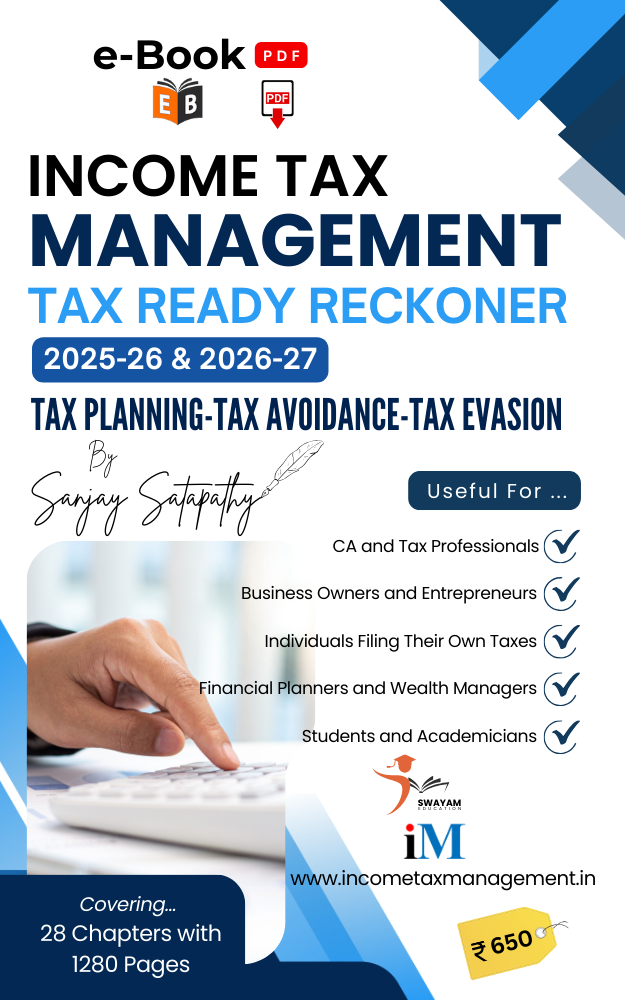Under Section 23(2) to (4) of the Income Tax Act, 1961, a self-occupied residential property (SOP) is taxed differently from let-out or deemed let-out properties. Here’s how the income is computed:
1. Basic Concept
For one self-occupied residential property (SOP), the Annual Value is considered NIL under Section 23(2). However, interest on home loan remains deductible.
2. Basic Rules for Self-Occupied Property (SOP)
- Only one propertycan be declared as self-occupied (tax-free)
- Annual Value (AV)is considered NIL for tax purposes
- Key benefit: Deduction for home loan interest (up to ₹2 lakh)
3. When Property Qualifies as Self-Occupied
A. Normally Self-Occupied [Section 23(2)]
- Property must be actually occupiedby owner for residence
- No rental income is generated
B. Deemed Self-Occupied [Section 23(3)]
Applies when:
- Owner cannot occupydue to employment/business
- Living in:
- Rented accommodation
- Employer-provided accommodation
- Other city due to work
- Property remains unlet(not rented out)
C. Multiple Properties [Section 23(4)]
- Only onecan be declared as self-occupied
- Additional properties are deemed let-out(taxed on fair rental value)
- Owner must be living in rented accommodation due to work
4. Computation Method
| PARTICULARS | AMOUNT |
| Gross Annual Value (GAV) | ₹0 (for one SOP) |
| Less: Municipal Taxes | – |
| Net Annual Value (NAV) | ₹0 |
| Less: Standard Deduction (30% of NAV) | – |
| Less: Interest on Home Loan (Section 24) | Up to ₹2,00,000 |
| Income from House Property | (Interest paid, max ₹2L) |
5. Special Cases
A. Multiple Properties (Section 23(4))
- Only one propertycan be declared as self-occupied
- Additional properties are deemed let-out(taxed on fair rental value)
B. Property Not Actually Occupied Due to Employment (Section 23(3))
- Still treated as self-occupied if:
- Owner is posted elsewhere
- Living in employer-provided accommodation
- Maintains property for own use (not rented out)
C. Partly Self-Occupied
- If portion is let out:
- Self-occupied part: GAV = ₹0
- Let-out part: Normal computation
6. Interest on Home Loan Deduction
- Pre-construction period interest:
- Deductible in 5 equal instalmentsfrom construction completion year
- Current year interest:
- Fully deductible (max ₹2L) for SOP
- No limit if deemed let-out
7. Practical Example
Example 1: Standard SOP
- A owns 1 house in Delhi (self-occupied)
- Home loan interest: ₹2.5 lakh
- Computation:
- GAV = ₹0
- Deduction = ₹2 lakh
- Taxable income = -₹2 lakh (loss)
Example 2: Unable to Occupy Due to Job
- B posted in Mumbai (lives in company flat)
- Owns locked house in Bangalore
- Interest: ₹3 lakh
- Computation:
- Treated as SOP under Section 23(3)
- Deduction = ₹2 lakh
- Loss = ₹2 lakh
Example 3: Multiple Properties
- C owns:
- House 1: Self-occupied (Delhi)
- House 2: Vacant (Mumbai)
- Computation:
- Delhi house: ₹0 income (₹2 lakh deduction)
- Mumbai house: Deemed let-out (taxed on fair rent)
8. Key Points to Remember
✅ Only one SOP allowed per taxpayer
✅ Interest deduction is primary benefit (₹2L cap)
✅ Unoccupied due to work still qualifies as SOP
✅ Multiple properties trigger deemed let-out rule
✅ Loss can be set off against other income (max ₹2L/year)


